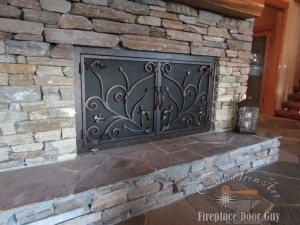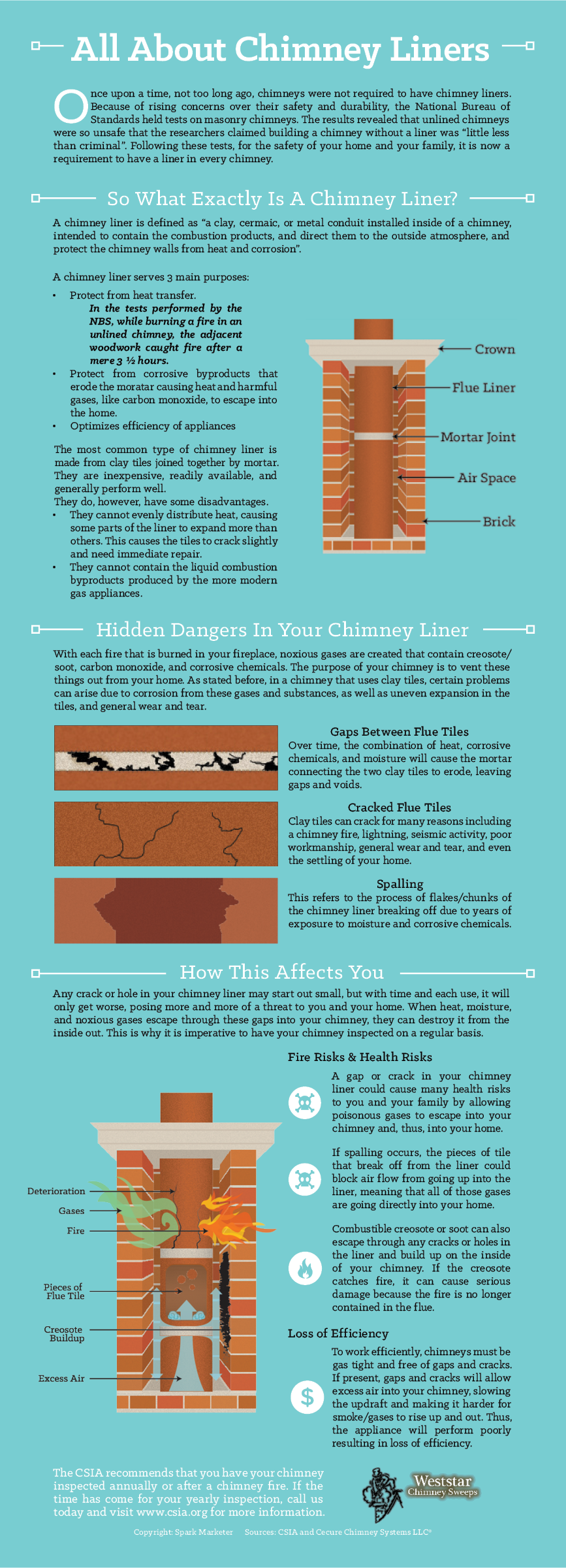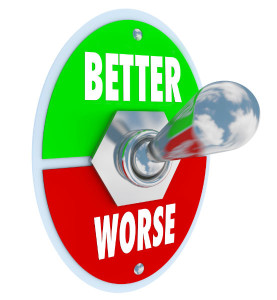Chimney Services » fire safety » Page 2
Our Company Blog
by Mike O'Mara | Sep 30, 2014 | Chimney Maintenance, fire safety

Don’t wait another day — schedule your own chimney sweeping today!
With temperatures dropping every day, winter will be here before we know it. Weststar Chimney Sweeps knows you want to start enjoying a warm fire in your fireplace as soon as you can, but we recommend your chimney be professionally swept and inspected by one of our CSIA-certified chimney sweeps before you light that first fire. According to the National Fire Prevention Association (NFPA), at least 12,000 Americans die every year in a house fire. One of the best ways to avoid having a devastating fire at your home is to have your chimney cleaned before the winter season.begins. The Chimney Safety Institute of America (CSIA), the NFPA, and other fire prevention and safety organizations recommend you have your chimney professionally swept and inspected at least once a year. Scheduling this annual sweeping and inspection in the late summer and early fall ensures your fireplace will be safe to use in the winter. We would like to tell you why it is so essential to have your chimney cleaned before you begin using it regularly in the colder months. We would also like to share some fire safety tips from the University of Nebraska-Lincoln.
Have Your Chimney Professionally Cleaned Before Winter
Safety is the main reason you should have your chimney swept and inspected before you light your first fire of the winter season. One of the biggest causes of chimney fires is large accumulations of creosote within your chimney. Developed naturally during the condensation process when the byproducts of combustion exit your chimney, creosote is highly flammable. If you neglect scheduling a professional chimney sweeping and inspection and large amounts of creosote remain inside your chimney, a home fire can be in your near future. Weststar Chimney Sweeps will be sure all creosote will be removed when we clean your chimney. We will also inspect your entire chimney to make sure there are no essential repairs. For example, a cracked chimney liner can lead to dangerous carbon monoxide leaking into your home, which can cause illness and possible death.
Other Safety Precautions for Winter
● Place some sort of shield, such as glass fireplace doors or a mesh screen, around your fireplace to keep sparks from jumping out and igniting a fire in your home.
● Make sure no flammable items are in the area around your fireplace just in case ash, sparks, or smoke exits your fireplace into your home.
● Use dry, seasoned firewood to build your fires. This type of wood cuts down on the amount of creosote produced when burning wood. Burning wet wood actually increases and speeds up the development of creosote deposits.
● Store your firewood off the ground to keep it dry and to prevent insects from living in the wood and entering your home when you bring it inside to burn. Few insects can survive if the wood is dry.
The fall is the busiest time of year for Weststar Chimney Sweeps. Contact us today to schedule an appointment with one of our chimney sweeps now so that you do not have to wait for weeks to have your pre-winter chimney cleaning and inspection.
by Mike O'Mara | Sep 13, 2014 | fire safety
We at Weststar Chimney Sweeps are excited to tell you about a new service we now offer — fireplace door installation. We have partnered with another company, Fireplace Door Guy, who custom designs fireplace doors. Once you have purchased and received your fireplace doors, our expert technicians will come to install these doors. We would like to take the opportunity to share with you the benefits of having fireplace doors.

Safety
According to the National Fire Protection Association (NFPA), every year thousands of homeowners experience property damage that could have been prevented if their fireplaces had doors. Even more serious, not having fireplace doors also causes thousands of deaths and injuries from house fires. How exactly do fireplace doors reduce dangerous home fires? Glass fireplace doors reduce the chances of sparks or logs falling out of the fireplace. This prevents damage to wood or tile flooring, destruction of carpet, and melting of linoleum floors. Additionally, you will not have to worry about sparks and cinders popping out of the fireplace and landing on clothing, furniture, and other household items, which can cause a destructive fire. Closing off the fireplace with glass doors has been proven to increase fire safety and prevention.
Increased Energy Efficiency
By minimizing and reducing air going out of your chimney, fireplace doors will save you money on both your heating and cooling expenses. An open fireplace is the same thing as an open window. If you do not have fireplace doors to close this window, warm air escapes your home in the winter, and cold, air conditioned air exits through your chimney during the summer. Remember, though, that if you are burning gas logs or a large wood-burning fire, you should open these doors.
Clean Up Reduction
When fireplace doors are closed, ash, wood chips, cinders, and other debris are contained, which decreases (or even eliminates!) the task of sweeping up these things after a fire. You also will not have to worry about ash smudges left by fallen ashes. Your household items near your fireplace are also protected from getting dirty from debris when the fireplace doors are closed.
Decor and Style
Adding fireplace doors can update the look of your hearth. One of the reasons Weststar Chimney Sweeps chose to partner with the Fireplace Door Guy is his variety of styles and designs of custom fireplace doors. Whether your decor tastes are classic and traditional or modern and contemporary, the Fireplace Door Guy has the perfect set of fireplace doors for you. With shapes ranging from rectangular to L-shaped to arched to U-shaped, you are certain to find the perfect fireplace doors for your hearth and home. You can even come up with your own design idea, and the Fireplace Door Guy can craft it from scratch.
If you would like to install fireplace doors, you can now contact Weststar Chimney Sweeps to do this service for you. Our staff can tell you more about these benefits of fireplace doors.
by Mike O'Mara | May 23, 2014 | Chimney Maintenance, fire safety
If you’re new to chimney ownership, it might surprise you when you learn not only that you need to be scheduling a professional chimney inspection each and every year, but that there are several different types of chimney inspections too.

It is vital to have your chimney inspected thoroughly at least once a year. Let our experts perform one of the three levels of inspection that is needed for your chimney.
Those different inspections are outlined as three different levels — 1, 2 and 3 — and Weststar Chimney Sweeps technicians are always happy to give you a rundown of when and why different inspections make sense for your system and your home. In the meantime, though, here are some basics to make those levels a little more clear:
Where Did These Levels Of Inspection Come From?
For a long time, the quality or thoroughness of your chimney inspection was largely left up to the individual professional doing the inspecting. While diligent, detailed chimney sweeps (like Weststar’s) have always been around, you generally just didn’t know what you’d get — a detailed peek into the state of your system, a quick glance with a flashlight and a mirror, or anything in between.
In January of 2000, the National Fire Protection Association outlined three different levels of inspection within NFPA 211, the standard by which our work — and the work of other CSIA-certified chimney technicians — is guided. This ensures that you receive a specific level of care, based on your chimney’s circumstances and needs, and that you know what to expect.
So What Should I Expect?
The Level of inspection that Weststar Chimney Sweeps technicians will recommend will be based on your specific system’s needs.
Level 1
If your system hasn’t changed — if you’re burning the same fuel in the same appliance with the same flue liner, etc. — you’ll do well with a Level 1 inspection, the least intricate (but still highly detailed) inspection. We’ll examine all of the readily accessible parts of your chimney, from the firebox up through the flue, interior to exterior, looking for structural soundness, performance issues (like obstructions or excess creosote) and damage (like flue liner cracks that could lead to a leak). After our inspection, we’ll share our detailed findings with you, and make any necessary recommendations.
Level 2
A more detailed Level 2 inspection makes the most sense in a couple of specific circumstances: when something in your system has changed, or if the property is changing hands. So if you’ve changed from wood to gas, added a new fireplace or insert, relined your flue or made other similar changes since your last inspection, Level 2 is appropriate. If you’re buying a home with a fireplace, a Level 2 inspection allows you to get the full picture of what’s about to become your responsibility — and potentially, your problem.
Level 2 inspections include that same thorough, top to bottom, in and out examination as Level 1, but we’ll also check your chimney in attics, basements and crawl spaces, look for proper clearance from combustible building materials and scan the flue using a specialized video camera that lets us get the closest look possible, and show our findings to you.
Level 3
A Level 3 inspection is really only recommended when a potential hazard is found and a closer look is needed — and that closer look can include removing building materials (like doors or drywall) that block off certain concealed areas. With these inspections, we’re leaving no stone unturned so we can be sure we’re aware of any dangerous or damaging problems that need to be addressed.
We’re always happy to talk chimneys — including inspections and other regular maintenance — with our valued clients. If you have questions, or would like to schedule your annual inspection, give Weststar Chimney Sweeps a call!
by Mike O'Mara | May 12, 2014 | Chimney Maintenance, fire safety
The exterior wall of your chimney is typically made of masonry. It cannot stand up to excessive heat well, so your flue liner does the job of protecting it.

by Mike O'Mara | Feb 25, 2014 | Chimney Maintenance, fire safety
Don’t Let It Accumulate
Did you know that the ash that is produced after burning combustible materials can still be used in other places? Did you also know that it’s not good to completely remove the ash? Despite the many toxins, there are still components in ash that make it beneficial and useful.
But Wait, There’s More

You don’t want to remove ALL of the ash from your fireplace. Leave some about an inch thick.
Ashes are made after burning combustible materials. They are powder-like and are not something you’d like to smell especially for people with sensitive noses. They are harmful to people but they can still benefit you if you have a garden. There are materials in the ash that can contribute to a healthy growing plant.
The ash should not be taken out completely, especially when you are constantly using your fireplace. This is because it might be difficult to start out a fire once you use it again; more time, more effort, less fire, less heat. An inch thick of ash will suffice. This can help protect the area in your firebox.
But removing ash in the fireplace is still something that needs our attention. It can cause all sorts of health hazards and can eventually end up starting a fire. Our company specializes in keeping your fireplace and chimney at optimal functioning level so it’s important to let us do our job. But in any case, you should also be aware of the things you need to do to successfully remove ash.
Removing the Ash
Get your metal trash bin, metal dust pan and broom ready for sweeping. Make sure that the ash is cool before you attempt to do any cleaning. The reason is to make sure that no hot coals are present. Once cooled, take out the firebox and sweep it and put the ash in the dust pan and into the trash bin. This step-by-step process should be done at least three to four times a week depending on the number of times you use your fireplace.
It’s good to let a CSIA-certified sweep do the cleaning. This is usually done when you have your inspection and clean-up. We’ve been serving the people of San Diego County for fifteen wonderful years, so feel confident with our certified techs. Feel free to contact us. We are happy to help.
by Mike O'Mara | Feb 17, 2014 | Chimney Maintenance, fire safety

Replacing parts of your chimney that are not properly functioning or are outdated can increase its performance and ensure safety.
Serving all of San Diego, California, West Star Chimney Sweeps offers an array of services to our customers. From chimney sweeping to dryer vent cleaning, we do everything we can to keep our customers secure, healthy, and confident in the safety and efficiency of their appliances. One of the things most frequently required of us are chimney part replacements. We often swap.
Why Your Chimney Needs to Be in Good Condition
Before we tell you about the chimney parts we replace most often, we want to tell you why it’s important to keep your chimney and all of its components in great working order. Simply put, a chimney that’s worn out may:
- Become a fire hazard
- Begin to leak and cause water damage
- Become clogged and unable to vent properly
- Vent toxic gases into your home
- Deteriorate beyond repair and require total replacement
West Star Chimney can make sure that your chimney and heating appliance are in great condition so that you don’t have to worry about any of these things happening.
Chimney and Fireplace Parts West Star Chimney Replaces Most Often
Among other replacements, we are often required to replace the following five parts on fireplaces and chimneys around San Diego:
- Chimney Caps: A brick and mortar chimney without a cap is like a house without a roof. Chimney caps play lots of important roles, including keeping water out, keeping birds and bees out, keeping sparks in, and eliminating downdrafts. By keeping the wrong stuff out and the right stuff in, you’ll protect your chimney from accumulating fire hazards (think leaves and limbs, nests, trash, and other debris) and reduce the chances of carbon monoxide poisoning and chimney fire. You’ll also be protecting your chimney, assuring its longer life, and safeguarding your home from expensive water damage.
- Dampers: Chimney dampers are perhaps our favorite chimney part to tell homeowners about. This is because we get to tell them how we’re about to save them money by installing a top-sealing damper atop their chimney. After all, having a chimney without a damper is not unlike leaving a window open year round; just imagine how much you’d spend on extra energy costs if you left a window open all the time. A damper will keep water and debris out of your chimney, but it’s most notable for the fact that the homeowner can open and close it, creating an airtight seal when the heating appliance is not in use.
- Hearth Screens: Whether or not you already have a hearth screen, West Star Chimney is happy to equip your fireplace with one. These screens offer lots of advantages, including peace of mind that if an errant spark flies out of your fireplace it will stay in your fireplace. It will also help keep pets and small children away from your fire and can update the look of your fireplace.
Have questions about caps, dampers, prefab panels, hearth screens, or any other chimney component? Call us at 619-338-8116 or schedule an appointment with us today using our online form.





